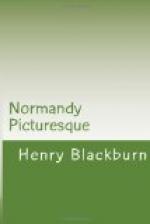Does the comparison seem far-fetched; and is it not well to make the contrast, if it may lead, however slightly, to a consideration of our own deformities? We believe that the time is coming when a great modification in the dress of our younger men will be adopted, if only for health and economy; it will come with the revival, or more general practice, of such games as singlestick, wrestling, and the like, and with an improved system of physical education. It sounds little better than a mockery to speak of deeds of valour and personal prowess, whilst we submit to confine our limbs in garments that cramp the frame and resist every healthy movement of the body. We must not go farther into the question in these pages, but we may ask—were there as many narrow-shouldered, weak-chested, delicate men, in the days when every gentleman knew how to use a sword?[60]
The extravagances and vagaries of modern costume (for which we can find no precedent in the comparative ignorance and barbarism of the middle ages) lead to the conviction that there must be a great change, if only as a question of health. Travellers who have been in Spain, notice with surprise that the men are wrapt literally ‘up to their eyes,’ in their cloaks, whilst the women walk abroad in the bitter wind with only a lace veil over their heads and shoulders; but the disproportionate amount of clothing that modern society compels men and women to wear in the same room seems equally absurd.[61]
And yet there must be some extraordinary fascination in the prevailing dress, that induces nearly every European nation to give up its proper costume and to be (as the saying is) ‘like other people.’ There is an old adage that you cannot touch pitch without being defiled, and with the people of whom we have been speaking, it certainly has its application. What is the Normandy peasant’s pride on high days and holidays in the year 1869, but to put on a ‘frock coat’ and a chapeau noir; to throw away the costume that his fathers wore, to bid farewell to colour, character, and freedom of limb, to don the livery of a high civilization, and to become (to our poor understanding) anything but the ‘noblest work of God.’
Again, in the little matter of WRITING, may we not learn something by looking back three or four hundred years—were not our ancestors a little more practical than ourselves? Did the monks of the middle ages find it necessary, in order to express a single word on paper or parchment, to make the pen (as we do) travel over a distance of eight or ten inches?[62] Here are two words,
[Illustration: excellentis]
one written by a lady, educated in the ‘pot-hook-and-hanger’ school, and another, the autograph of William of Malmesbury, an historian of the twelfth century. Is the modern method of writing much more legible than the old—is it more easily or quickly written; and might not we adopt some method of writing, by which to express our meaning in a letter, at less length than thirty feet?




